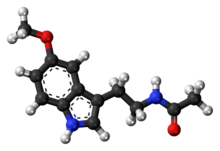
Back ميلاتونين Arabic Melatonin Azerbaijani ملاتونین AZB Мелатанін Byelorussian Мэлятанін BE-X-OLD Мелатонин Bulgarian Melatonin BS Melatonina Catalan مێلاتۆنین CKB Melatonin Czech

| |

| |
| Names | |
|---|---|
| IUPAC name
N-[2-(5-methoxy-1H-indol-3-yl)ethyl]acetamide
| |
| Other names
5-Methoxy-N-acetyltryptamine; N-Acetyl-5-methoxytryptamine; NSC-113928
| |
| Identifiers | |
3D model (JSmol)
|
|
| ChEBI | |
| ChEMBL | |
| ChemSpider | |
| DrugBank | |
| ECHA InfoCard | 100.000.725 |
| EC Number |
|
| KEGG | |
| MeSH | Melatonin |
PubChem CID
|
|
| UNII | |
CompTox Dashboard (EPA)
|
|
| |
| |
| Properties | |
| C13H16N2O2 | |
| Molar mass | 232.281 g/mol |
| Melting point | 117 |
Except where otherwise noted, data are given for materials in their standard state (at 25 °C [77 °F], 100 kPa).
| |
Melatonin, an indoleamine, is a natural compound produced by various organisms, including bacteria and eukaryotes.[1] Its discovery in 1958 by Aaron B. Lerner and colleagues stemmed from the isolation of a substance from the pineal gland of cows that could induce skin lightening in common frogs. This compound was later identified as a hormone secreted in the brain during the night, playing a crucial role in regulating the sleep-wake cycle, also known as the circadian rhythm, in vertebrates.[2][3]
In vertebrates, melatonin's functions extend to synchronizing sleep-wake cycles, encompassing sleep-wake timing and blood pressure regulation, as well as controlling seasonal rhythmicity (circannual cycle), which includes reproduction, fattening, molting, and hibernation.[4] Its effects are mediated through the activation of melatonin receptors and its role as an antioxidant.[5][6][7] In plants and bacteria, melatonin primarily serves as a defense mechanism against oxidative stress, indicating its evolutionary significance.[8] The mitochondria, key organelles within cells, are the main producers of antioxidant melatonin,[9] underscoring the molecule's "ancient origins" and its fundamental role in protecting the earliest cells from reactive oxygen species.[10][11]
In addition to its endogenous functions as a hormone and antioxidant, melatonin is also administered exogenously as a dietary supplement and medication. It is utilized in the treatment of sleep disorders, including insomnia and various circadian rhythm sleep disorders.
- ^ Amaral FG, Cipolla-Neto J (2018). "A brief review about melatonin, a pineal hormone". Archives of Endocrinology and Metabolism. 62 (4): 472–479. doi:10.20945/2359-3997000000066. PMC 10118741. PMID 30304113. S2CID 52954755.
- ^ Auld F, Maschauer EL, Morrison I, Skene DJ, Riha RL (August 2017). "Evidence for the efficacy of melatonin in the treatment of primary adult sleep disorders" (PDF). Sleep Medicine Reviews. 34: 10–22. doi:10.1016/j.smrv.2016.06.005. hdl:20.500.11820/0e890bda-4b1d-4786-a907-a03b1580fd07. PMID 28648359.
- ^ Faraone SV (2014). ADHD: Non-Pharmacologic Interventions, An Issue of Child and Adolescent Psychiatric Clinics of North America, E-Book. Elsevier Health Sciences. p. 888. ISBN 978-0-323-32602-5.
- ^ Altun A, Ugur-Altun B (May 2007). "Melatonin: therapeutic and clinical utilization". International Journal of Clinical Practice. 61 (5): 835–45. doi:10.1111/j.1742-1241.2006.01191.x. PMID 17298593. S2CID 18050554.
- ^ Boutin JA, Audinot V, Ferry G, Delagrange P (August 2005). "Molecular tools to study melatonin pathways and actions". Trends in Pharmacological Sciences. 26 (8): 412–9. doi:10.1016/j.tips.2005.06.006. PMID 15992934.
- ^ Hardeland R (July 2005). "Antioxidative protection by melatonin: multiplicity of mechanisms from radical detoxification to radical avoidance". Endocrine. 27 (2): 119–30. doi:10.1385/ENDO:27:2:119. PMID 16217125. S2CID 46984486.
- ^ Reiter RJ, Acuña-Castroviejo D, Tan DX, Burkhardt S (June 2001). "Free radical-mediated molecular damage. Mechanisms for the protective actions of melatonin in the central nervous system". Annals of the New York Academy of Sciences. 939 (1): 200–15. Bibcode:2001NYASA.939..200R. doi:10.1111/j.1749-6632.2001.tb03627.x. PMID 11462772. S2CID 20404509.
- ^ Tan DX, Hardeland R, Manchester LC, Korkmaz A, Ma S, Rosales-Corral S, Reiter RJ (January 2012). "Functional roles of melatonin in plants, and perspectives in nutritional and agricultural science". Journal of Experimental Botany. 63 (2): 577–97. doi:10.1093/jxb/err256. PMID 22016420.
- ^ Reiter RJ, Tan DX, Rosales-Corral S, Galano A, Zhou XJ, Xu B (2018). "Mitochondria: Central Organelles for Melatonin's Antioxidant and Anti-Aging Actions". Molecules. 23 (2): 509. doi:10.3390/molecules23020509. PMC 6017324. PMID 29495303.
- ^ Manchester LC, Coto-Montes A, Boga JA, Andersen LP, Zhou Z, Galano A, Vriend J, Tan DX, Reiter RJ (2015). "Melatonin: an ancient molecule that makes oxygen metabolically tolerable". Journal of Pineal Research. 59 (4): 403–419. doi:10.1111/jpi.12267. PMID 26272235. S2CID 24373303.
- ^ Zhao D, Yu Y, Shen Y, Liu Q, Zhao Z, Sharma R, Reiter RJ (2019). "Melatonin Synthesis and Function: Evolutionary History in Animals and Plants". Frontiers in Endocrinology. 10: 249. doi:10.3389/fendo.2019.00249. PMC 6481276. PMID 31057485.